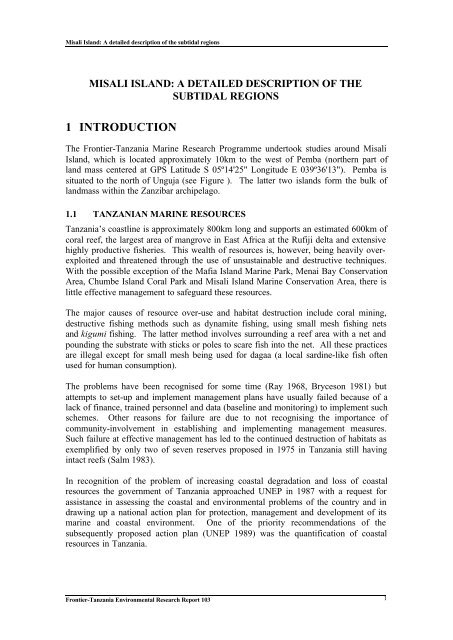Frontier-Tanzania Environmental Research REPORT 103 Misali Island
Frontier-Tanzania Environmental Research REPORT 103 Misali Island
Frontier-Tanzania Environmental Research REPORT 103 Misali Island
You also want an ePaper? Increase the reach of your titles
YUMPU automatically turns print PDFs into web optimized ePapers that Google loves.
<strong>Misali</strong> <strong>Island</strong>: A detailed description of the subtidal regionsMISALI ISLAND: A DETAILED DESCRIPTION OF THESUBTIDAL REGIONS1 INTRODUCTIONThe <strong>Frontier</strong>-<strong>Tanzania</strong> Marine <strong>Research</strong> Programme undertook studies around <strong>Misali</strong><strong>Island</strong>, which is located approximately 10km to the west of Pemba (northern part ofland mass centered at GPS Latitude S 05º14'25" Longitude E 039º36'13"). Pemba issituated to the north of Unguja (see Figure ). The latter two islands form the bulk oflandmass within the Zanzibar archipelago.1.1 TANZANIAN MARINE RESOURCES<strong>Tanzania</strong>’s coastline is approximately 800km long and supports an estimated 600km ofcoral reef, the largest area of mangrove in East Africa at the Rufiji delta and extensivehighly productive fisheries. This wealth of resources is, however, being heavily overexploitedand threatened through the use of unsustainable and destructive techniques.With the possible exception of the Mafia <strong>Island</strong> Marine Park, Menai Bay ConservationArea, Chumbe <strong>Island</strong> Coral Park and <strong>Misali</strong> <strong>Island</strong> Marine Conservation Area, there islittle effective management to safeguard these resources.The major causes of resource over-use and habitat destruction include coral mining,destructive fishing methods such as dynamite fishing, using small mesh fishing netsand kigumi fishing. The latter method involves surrounding a reef area with a net andpounding the substrate with sticks or poles to scare fish into the net. All these practicesare illegal except for small mesh being used for dagaa (a local sardine-like fish oftenused for human consumption).The problems have been recognised for some time (Ray 1968, Bryceson 1981) butattempts to set-up and implement management plans have usually failed because of alack of finance, trained personnel and data (baseline and monitoring) to implement suchschemes. Other reasons for failure are due to not recognising the importance ofcommunity-involvement in establishing and implementing management measures.Such failure at effective management has led to the continued destruction of habitats asexemplified by only two of seven reserves proposed in 1975 in <strong>Tanzania</strong> still havingintact reefs (Salm 1983).In recognition of the problem of increasing coastal degradation and loss of coastalresources the government of <strong>Tanzania</strong> approached UNEP in 1987 with a request forassistance in assessing the coastal and environmental problems of the country and indrawing up a national action plan for protection, management and development of itsmarine and coastal environment. One of the priority recommendations of thesubsequently proposed action plan (UNEP 1989) was the quantification of coastalresources in <strong>Tanzania</strong>.<strong>Frontier</strong>-<strong>Tanzania</strong> <strong>Environmental</strong> <strong>Research</strong> Report <strong>103</strong> 1
















